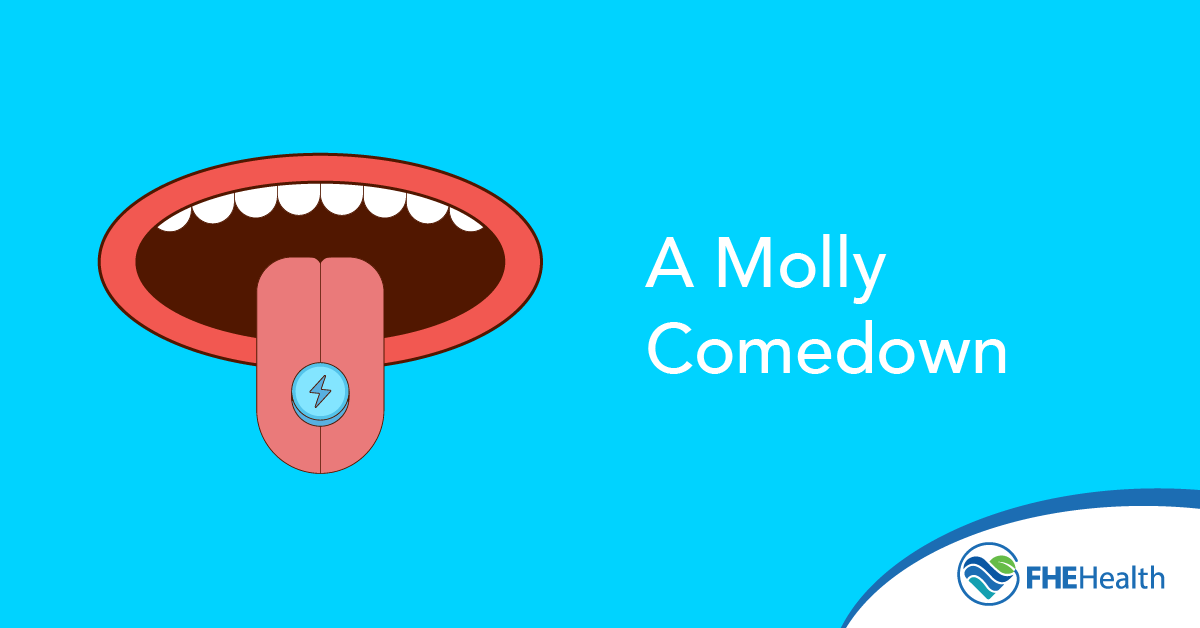
People use Molly for its euphoric and energizing effects. Yet the drug, also known formally as “3,4-methylenedioxymethamphetamine” and informally as “MDMA” or “ecstasy,” can have very unpleasant aftereffects. Many users experience what’s called a “Molly comedown” or “Molly hangover.” This happens after the initial effects of the drug have worn off and is marked by exhaustion, brain fog, and a depressed mood. These symptoms occur as part of the MDMA comedown process, which happens as the brain tries to rebalance after the drug’s effects are wearing off.
What happens during a Molly comedown? How do you recognize it when it’s happening, and how do you recover safely? Answers to these questions can help users reduce potential harm and recognize when it’s time to reach out for help….
What Happens During a Molly (MDMA) Comedown?
MDMA’s primary effect on the brain is to encourage it to release a large amount of serotonin, which is an important neurotransmitter that’s responsible for everything from mood regulation to sleep. This surge of serotonin is responsible for the euphoric feelings and boost of energy that Molly users experience. Your body also has a physical response, with an increase in heart rate and body temperature. The problem is that when the drug’s effects wear off, the brain is left with less serotonin than normal. This lack of serotonin produces the opposite effects: exhaustion, depressed mood, and physical symptoms like digestive problems or headaches.
How long a Molly comedown lasts and how severe the symptoms are depend largely on the potency of the drug, how much the person took, whether other substances were used, and the person’s health. For example, if the person was well-hydrated and in otherwise good health, the comedown may be shorter or less intense. In most cases, the comedown period starts within a few hours of taking the drug and can last for 1-3 days.
Common Symptoms and Emotional Effects
Because the symptoms of a Molly comedown are so varied, they can be harder to recognize. This may be especially true if someone is using the drug to self-medicate to begin with. For example, if someone is experiencing depression and uses Molly as a way to cope, they may think the comedown is just “back to normal.” Molly comedown symptoms fall into three main categories.
Cognitive
- Difficulty concentrating. It can be harder to focus on specific tasks or a conversation, and even simple daily activities can require more effort.
- Experiencing brain fog. You may feel like your brain is working more slowly than normal or like your thoughts are harder to organize.
- Having trouble with memory and recall. Short-term memory is most likely to be affected, and you may also experience lost time or feel like you blacked out at some point.
- Difficulty making decisions. The brain fog and reduced cognitive function can make it harder to make even simple decisions, such as what to eat for lunch.
- Feeling disoriented or confused. You may feel like you aren’t quite “with it” or that you don’t understand what’s happening around you.
Emotional
- Wanting to withdraw from friends or activities you generally enjoy. It’s common to lose interest in socializing or your usual hobbies. Being around people may seem like too much pressure when you’re feeling low.
- Feeling isolated or alone. This can occur even when other people are around. You may feel disconnected from others or like you can’t relate to them.
- Feeling depressed or sad. As your brain deals with the drop in serotonin, depression symptoms may occur. This may be more intense in those who already struggle with clinical depression or other mental health issues.
- Experiencing overwhelming emotions or feeling emotionally drained. You may have a rapidly changing mood and feel everything intensely. Crying easily or bouts of explosive anger are common.
- An increase in anxiety. The chemical changes in the brain can increase hypervigilance and other symptoms of anxiety.
- Experiencing dissociation or like what’s happening around you isn’t real. In some cases, users feel detached from their surroundings or emotionally numb. It can feel like the Molly high was so intense that everything else pales in comparison.
Physical
- Exhaustion. As the effects of the drug wear off, you’re likely to feel intense fatigue even after sleeping.
- Feeling rundown or like you are getting sick. You may experience flu-like symptoms during the comedown process, and in some cases, a weakened immune response, which can result in an actual illness.
- Muscle aches and headaches. Joint and muscle pain is common, especially if you were more active than normal while experiencing the high.
- Changes in sleep habits. Many people find that they have difficulty sleeping for a few days, but you may also sleep much more than normal.
- Nausea, digestive upset, or loss of appetite. Serotonin plays a major role in the gut, and a Molly comedown often involves a disinterest in food or nausea.
- Dehydration. Because of the increase in heart rate and body temperature when on Molly, the body goes through more fluid than normal. This can result in dehydration, which can cause other symptoms, such as feeling dizzy when you stand up.
If your symptoms are severe or last longer than a few days, it’s important to seek medical attention. IV fluids, anti-nausea medications, and other treatments can help, and a health care provider can also connect you with addiction treatment specialists if you’re ready to get help.
Physical Recovery Tips
Prioritizing your physical health after MDMA use may reduce the intensity or duration of the comedown and help you recover more quickly. Focusing on the three main pillars of physical health — sleep, nutrition, and hydration — is key. Even if you aren’t able to fall asleep, resting quietly without watching TV or scrolling on your phone can help your body get the rest it needs. Drink plenty of fluids and consider adding electrolytes or coconut water to your drink for an extra boost. Nutritious foods that are easy on the stomach include things like bone broth or smoothies, but the best thing to eat during a Molly comedown is anything that sounds appetizing. Light exercise, such as a walk around the block, if you feel up to it, can help your body process the drug and rebalance as the effect wears off.
Dangers of Frequent Use and Comedown Cycles
One thing to keep in mind is that the intensity and duration of a Molly comedown generally increase with frequent use. Repeated high and low cycles can cause chronic serotonin depletion and increase your risk of developing mental health conditions, such as depression and anxiety. In some cases, users may try to avoid a comedown by taking repeated doses of MDMA as soon as the effects start to wear off, which can be dangerous and dramatically increase the risk of overdose. Long-term MDMA use can also result in serotonin syndrome, which can be life-threatening.
Long-Term Mental Health Complications
Long-term Molly use can interfere with brain function, making it harder to regulate your mood and emotions even after the MDMA comedown has passed. In some cases, users experience chronic feelings of detachment, anxiety, depression, or numbness that can last for months. All of these symptoms can increase the risk of developing other mental health conditions, such as an anxiety or depressive disorder. Users may also experience feelings of shame, guilt, or lack of control as they struggle with ongoing substance use. If you feel like your drug use is negatively impacting your life and you’re ready to make a change, reach out for help.






